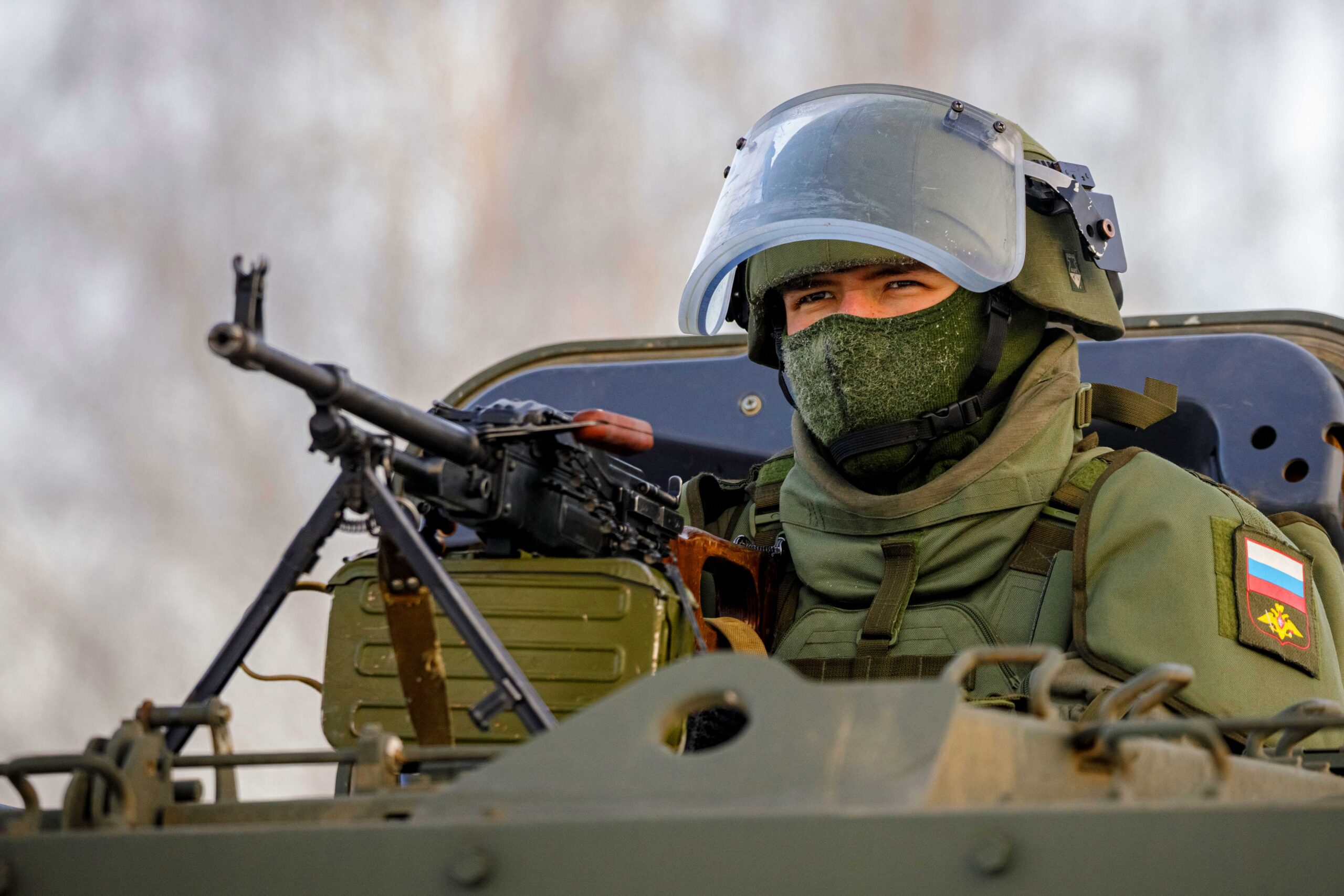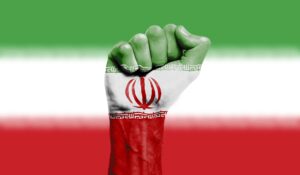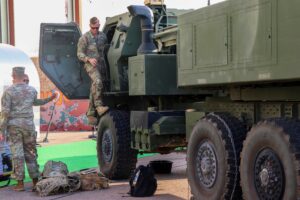Introduction
Russia has for long been among the largest exporters of arms in the world, and has stood as the second largest exporter after the USA, with the exception of 2019-2023, when it was narrowly overtaken by France. The SIPRI Arms Transfers Database contains information on all transfers of major conventional arms from 1950 to the most recent full calendar year. Arms transfers data in this article will reference the SIPRI Arms Transfers Database.
In 2009-2013 and 2014-2018, Russian exports of major arms decreased by 14%. In 2014-2018 and 2019-2023, they decreased by a further 53%. In 2022, Russia exported major arms to 14 states. In 2023, this decreased to 12, two of them (Algeria and Iran) being in the MENA region.
In 2019-2023, India and China were the largest arms importers from Russia, accounting for 34% and 21% of Russia’s exports of major arms respectively. India was also the largest recipient of Russian arms in 2014–18. However, Russia’s exports to India decreased by 34% in 2014-2018 and 2019-2023, and its exports to China decreased by 39%. Russian arms exports to Algeria and Vietnam, Russia’s third and fourth largest recipients of arms in 2014-2018, decreased by 83% and 91% respectively. These represent significant decreases in Russian exports to two major markets for Russian arms.[i]
Russia’s needs in Ukraine have pressured its arms industry, needing to mobilize significant resources.
Russia’s invasion of Ukraine is one of the primary reasons for these changes. Russia’s needs in Ukraine have pressured its arms industry, needing to mobilize significant resources.[ii] In addition to this, sanctions from the USA and its Western partners in response to the invasion have also impacted Russia’s arms industry negatively, bringing about significant difficulties in acquiring components needed for the production of weapons systems. Moscow has actively been trying to work around these challenges.[iii] [iv] In the case of semiconductors, for example, it has attempted to bypass the restrictions by buying chips from China,[v] which the USA quickly responded to by widening the scope of its sanctions.[vi]
However, outside of the context of the war, there are additional notable factors that can explain why Russia’s exports of major arms have been decreasing.[vii] India and China, who have traditionally been major markets for Russian arms exports, have been developing their own competitive arms industries, relying less and less on imports from Russia.[viii] On the other hand, other countries have been diversifying their arms suppliers.
In other countries still, it is perceptions that Russia’s needs in Ukraine will overpower its arms industry that led to a policy change on arms imports. Some doubt Russia’s abilities to continue supplying arms and spare equipment, and as a result, they are speeding up the diversification of their arms suppliers[ix] [x] Cases in point are India and Malaysia. US pressure on countries to import less from Russia also plays a role. Some states have reportedly cancelled deals or refused to buy Russian weapons in the face of sanction threats.[xi]
Russian arms exports will continue to remain low for some time to come.
It is reasonable to expect, based on low levels of new orders and questions about Russia’s ability to even fulfil them, that Russian arms exports will continue to remain low for some time to come. Russian exports of major arms have decreased dramatically after the start of the invasion, but its long-term effects are still difficult to ascertain.
Overview of Russian Arms Exports—Middle East and North Africa
In 2009-2013 and 2014-2018, overall arms exports to the Middle East increased by 77%. In 2014-2018 and 2019-2023, they decreased by 12%.
In 2009-2013, Russia supplied 16% of the Middle East’s imports of major conventional arms. In 2014-2018, Russia supplied just 10% of the region’s needs, however, this still represented an increase of 14% in Russian arms exports to the region compared to 2009-2013. These figures show that total exports of major arms to the Middle East increased in 2009-2013 and 2014-2018, while Russia’s share of those arms exports simultaneously decreased.
In 2019-2023, Russia supplied just 4.6% of the Middle East’s arms imports, and exported 61% less arms to the Middle East compared with 2014-2018. The drop was notable in 2022, the year when the Russian invasion of Ukraine began, resulting in Russia not exporting any major arms to the Middle East in 2022.
Syria
In 2014-2018, Russia supplied 88% of all transfers of major arms to Syria, while in 2019-2023, it was the sole supplier of the country, even though exports decreased by 52% compared to 2014-2018. Arms transfers to Syria included tanks, infantry fighter vehicles and air defense systems. In 2022-2023, virtually no transfers to Syria took place.
GCC States
GCC states have accounted for a small part of Russian arms sales in general. In 2009-2013, Russian arms transfers made up 7% of total arms sales to GCC countries. In 2014-2018, they decreased further to a mere 0.5%. In 2019-2023, they rose in volume by 38% to account for 0.6% of total arms sales to the GCC. Shipments to GCC states primarily included missiles to the UAE and Qatar. In 2021 and 2023, there were virtually no transfers of major arms from Russia to the GCC states.
Egypt
Egypt has been a key importer of Russian arms. In 2019-2023, it was the third largest arms importer from Russia, but received 54% less arms from Russia in comparison to the previous 5-year period.
After the military coup in 2013, relations between the USA and Egypt started to take a downward turn, which played a role in Egyptian calculations of strengthening relations with Russia. Significant contracts to procure Russian weapons in 2014 and 2015 included air defense systems and combat aircraft.[xii]
In 2014-2018 and 2019-2023, the share of imports of major arms from Russia decreased from 31% to 20%, while those from Germany and Italy increased considerably. Germany and Italy accounted for 27% and 22% of Egypt’s imports of major arms during this period respectively. There have been no exports of major arms by Russia to Egypt since 2021. Egypt even ended a deal for Russian combat aircraft during this time, due in large part to pressure from the USA.[xiii]
Türkiye
In 2014-2018, there were no transfers of major arms from Russia to Türkiye. In 2019-2023, Russian exports made up 15% of all Turkish imports of major arms. The most significant arms transfers were for missiles and air defense systems. Notable during this period is Türkiye’s acquisition of the Russian S-400 air defense system, which resulted in sanctions being placed on the country by President Donald Trump’s administration and its subsequent removal from the F-35 program.[xiv] Although there has been some improvement in Turkish-American bilateral relations since Türkiye’s acceptance of Sweden’s accession to NATO, Ankara has not regained access to the F-35 program.[xv]
North Africa
In 2009-2013, Russia supplied 52% of North Africa’s imports of major arms. This decreased slightly to 49% in 2014-2018. In 2019-2023, Russia’s share of North Africa’s imports of major arms dropped to 32%.
The largest arms importer in North Africa is Algeria, which accounted for 53% of total arms imports to the region in 2019 and 2023. Imports from Russia accounted for 48% in 2019-2023 (down from 66% In 2014-2018). Algeria’s finance law for 2024 shows a high priority for national defense, with a defense budget of approximately $22 billion, with approximately $3.5 billion set aside for national defense.[xvi] Algeria may look to import further weapons from Russia over the coming years, but Algiers also has other suppliers, including China, Germany, Italy and France.
The Case of Iran
Iran has relied on Russia for most of its imports of major arms in the last decade. This has mostly been in the form of air defense systems, missiles, and a range of sensors. In 2009 and 2013, Russia supplied 37% of Iran’s imports of major arms. In the period from 2014 to 2018 this rose to a staggering 96%. 2019-2023 saw Russia’s emergence as the sole supplier of major arms to Iran. Russian arms exports to Iran decreased by as much as 94% in 2014-2018 and 2019-2023. In 2019-2023, transfers of major arms from Russia to Iran accounted for just 0.2% of all Russian arms exports.
Compared to other states in the MENA region, Iran is a minor importer of major arms. In 2019-2023, arms imports by Iran accounted for 0.1% of arms imports in the Middle East, while Saudi Arabia and Qatar accounted for 28% and 25% respectively.
A recent order was made by Iran for Russian combat aircraft. Deliveries for the Russian Yak-130 have already begun, and a deal for the Su-30MK fighter jet was reportedly finalized at the end of 2023.[xvii] Assuming that the aircraft will be delivered, this would represent a breakthrough in Russian arms exports to Iran. There has also been much in the way of licensed production of Russian weapons in Iran, including anti-tank missiles, infantry fighter vehicles, and tanks.
Relations between Iran and Russia were strengthened with a deal in 2022 for Iran to supply Russia with drones and missiles in order to aid its war efforts against Ukraine.[xviii] So far, Tehran has supplied Shahed-136 and Mohajer-6 drones to Moscow. This cooperation also involves establishing a factory in Russia to produce a Russian drone based on the Iranian Shahed’s design.[xix] [xx] The support Iran is providing Russia at this time could also be a reason for Russia to be more forthcoming with arms transfers in the future.[xxi]
The US and Israel have expressed deep concerns about the transfer of arms from Iran to Russia, and vice versa.[xxii] The potential transfer of missiles has particularly sounded alarm bells among the G7 states, which consider such a transfer “a substantive material escalation in its support for Russia’s war in Ukraine.”[xxiii]
Iran imported arms from various states before 1990, including the USSR, North Korea and China. This continued into the 1990s. Arms embargos on the country in the mid-2000s imposed by the USA and the UN, however, put considerable restrictions on these transfers. Iran subsequently had to rely on fewer states, chiefly Russia and China, in addition to its own domestic arms production industry, mainly producing drones and missiles.
It has been difficult for Iran to upgrade its capabilities and keep up with those of the US and Israel.
Due to multiple rounds of sanctions imposed on the country since 1979, it has been difficult for Iran to upgrade its capabilities and keep up with those of the US and Israel. Iran’s recent attack on Israel and the latter’s subsequent retaliation in April 2024 will certainly increase the perceived urgency of securing such upgrades, and acquire advanced offensive and defensive capabilities, particularly aircraft and air defense systems.
Conclusion
Russian arms exports have decreased within the last 10 years—both generally and to the MENA region specifically—with a particularly sharp decline since Russia’s invasion of Ukraine in 2022.
Notwithstanding, the MENA region is an area where Russia prioritizes extending its influence through various means, including military involvement, preferential bilateral relations, and economic cooperation. The Concept of the Foreign Policy of the Russian Federation, updated in March 2023, stated Russia’s commitment to continue developing its ties with Iran and Syria, deepen its partnerships with Türkiye, Saudi Arabia, Egypt and other member states of the Organization of Islamic Cooperation, “given the extent of their sovereignty and constructiveness of their policy toward the Russian Federation.” [xxiv] Russia’s domestic arms production will be preoccupied with supplying the war machine in Ukraine for the foreseeable future. Reportedly, Russia has even had to ask customers to return military equipment previously exported to them.[xxv] Low levels of new orders and Russia’s current challenges with exporting arms mean that the future of its exports of major arms to the MENA region is uncertain. While a breakthrough in Ukraine—by military or diplomatic means—might open up opportunities for the renewal of increased levels of exports, this will largely be dependent on the state of the country’s economy following the war and the interest of MENA states in importing further from Russia.
[i] Wezemen, P., Djokic, K., George, M., Hussain, Z., Wezemen, S., (2024). ‘Trends in International Arms Transfers, 2023’, SIPRI, March 2024, retrieved from https://doi.org/10.55163/PBRP4239.
[ii] Bergman, M., Snegovaya, M., Dolbaia, T., Fenton, N., (2023). ‘Seller’s Remorse: The Challenges Facing Russia’s Arms Exports’, CSIS, 18 September 2023, retrieved from https://www.csis.org/analysis/sellers-remorse-challenges-facing-russias-arms-exports.
[iii] Corera, G., (2024). ‘Russia ‘Struggling with supply of weapons and ammunition for Ukraine war – Western officials’, BBC, 21 February 2024, retrieved from https://www.bbc.com/news/world-europe-68364924.
[iv] Busvine, D., (2024). ‘Russia finds way around sanctions on battlefield tech: report’, Politico, 11 January 2024, retrieved from https://www.politico.eu/article/russia-find-way-around-sanctions-battlefield-tech-report/.
[v] Miller, C., (2024). ’The Impact of Semiconductor Sanctions on Russia’, American Enterprise Institute, 2 April 2024, retrieved from https://www.aei.org/research-products/report/the-impact-of-semiconductor-sanctions-on-russia/.
[vi] Mohammed, A., Lawder, D., Freifeld, K., (2024). US expands Russia sanctions, targets chips sent via China,’ Reuters, 13 June 2024, retrieved from https://www.reuters.com/world/us-widens-russia-sanctions-targets-semiconductors-sent-via-china-2024-06-12/.
[vii] Bergman, M., Snegovaya, M., Dolbaia, T., Fenton, N., (2023). ‘Seller’s Remorse: The Challenges Facing Russia’s Arms Exports’, CSIS, 18 September 2023, retrieved from https://www.csis.org/analysis/sellers-remorse-challenges-facing-russias-arms-exports.
[viii] Kaushik, K., (2024). India pivots away from Russian arms, but will retain strong ties,’ Reuters, 29 January 2024, retrieved from https://www.reuters.com/world/india/india-pivots-away-russian-arms-will-retain-strong-ties-2024-01-28/.
[ix] Kaushik, K., (2024). India pivots away from Russian arms, but will retain strong ties,’ Reuters, 29 January 2024, retrieved from https://www.reuters.com/world/india/india-pivots-away-russian-arms-will-retain-strong-ties-2024-01-28/.
[x] Huxley, T., (2023). ’Malaysia’s defence policy under the Anwar government,’ IISS, 8 September 2023, retrieved from https://www.iiss.org/en/online-analysis/online-analysis/2023/09/malaysias-defence-policy-under-the-anwar-government/.
[xi] Greenlees, D., (2019). ‘Russia sanctions putting strain on US relationship with Indonesia,’ Asialink- University of Melbourne, 18 June 2019, retrieved from https://asialink.unimelb.edu.au/asialink-dialogues-and-applied-research/commentary-and-analysis/russia-sanctions-putting-strain-on-us-relationship-with-indonesia.
[xii] Kulmova, A., (2019). ’Russia’s Arms Exports to the MENA Region: Trends and Drivers’, EuroMeSCo, 1 April 2019, retrieved from https://www.euromesco.net/wp-content/uploads/2019/03/Brief95-Russia-Arms-transfer-to-the-MENA-region.pdf
[xiii] Lake, J., (2024). ‘Egypt goes shopping for pick and mix’, Times Aerospace, 17 May 2024, retrieved from https://www.timesaerospace.aero/features/defence/egypt-goes-shopping-for-pick-and-mix.
[xiv] Macias, A., (2020). ‘U.S. sanctions Turkey over purchases of Russian S-400 missile system’, CNBC, 14 December 2020, retrieved from https://www.cnbc.com/2020/12/14/us-sanctions-turkey-over-russian-s400.html#:~:text=The%20Trump%20administration%20imposed%20sanctions,%2Dto%2Dair%20missile%20system.
[xv] MENA Research Center., (2024). ”Rapprochement In US and Türkiye’, 8 May 2024, retrieved from https://www.mena-researchcenter.org/rapprochement-In-us-and-turkiye/.
[xvi] Ministry of Finance, Algeria., (2024). ‘Finance Law 2024’, 17 April 2024, retrieved from https://www.mfdgi.gov.dz/legislation-fiscale-ar/lois-des-financesar#513-599-2021-2024.
[xvii] Helou, A., (2023). Iran claims it has finalized long-waited deal for Russian fighter jets, helos’, 28 November 2023, retrieved from https://breakingdefense.com/2023/11/iran-claims-it-has-finalized-long-awaited-deal-for-russian-fighter-jets-helos/.
[xviii] Reuters, (2022). ’Iran agrees to ship missiles, more drones to Russia’, 19 October 2022, retrieved from https://www.reuters.com/world/exclusive-iran-agrees-ship-missiles-more-drones-russia-defying-west-sources-2022-10-18/.
[xix] Reuters, (2023). ’Report: Construction Progresses at Russian Plant for Iranian Drones’, VOA News, 13 November 2023, retrieved from https://www.voanews.com/a/report-construction-progresses-at-russian-plant-for-iranian-drones/7353887.html.
[xx] Warrick, J., Mekhennet, S., Nakashima, E., (2022). ’Iran will help Russia build drones for Ukraine war, Western officials say’, Washington Post, 19 November 2022, retrieved from https://www.washingtonpost.com/national-security/2022/11/19/russia-iran-drones-secret-deal/.
[xxi] Nissenbaum, D., Strobel, W P., (2023). ‘Moscow, Tehran Advance Plans for Iranian-Designed Drone Facility in Russia’, The Wall Street Journal, 5 February 2023, retrieved from https://www.wsj.com/world/moscow-tehran-advance-plans-for-iranian-designed-drone-facility-in-russia-11675609087.
[xxii] Meyer, H., (2024). ‘Russia-Iran Military Alliance Gives Israel Cause for Concern’, Bloomberg, 26 April 2024, retrieved from https://www.bloomberg.com/news/articles/2024-04-26/russia-iran-military-alliance-gives-israel-cause-for-concern
[xxiii] European Council of the European Union, (2024), ‘G7 Leaders’ statement on Iran’, 15 March 2024, retrieved from https://www.consilium.europa.eu/en/press/press-releases/2024/03/15/g7-leaders-statement-on-iran/.
[xxiv] The Ministry of Foreign Affairs of the Russian Federation, (2023). ‘The Concept of the Foreign Policy of the Russian Federation’, 31 March 2023, retrieved from https://mid.ru/en/foreign_policy/fundamental_documents/1860586/.
[xxv] Khalid, T., (2023). Russia asks countries among its arms customers to return weapons sold to them: Report’, Al Arabiya News, 9 November 2023, retrieved from https://english.alarabiya.net/News/world/2023/11/09/Russia-asks-countries-among-its-arms-customers-to-return-weapons-sold-to-them-Report.

















